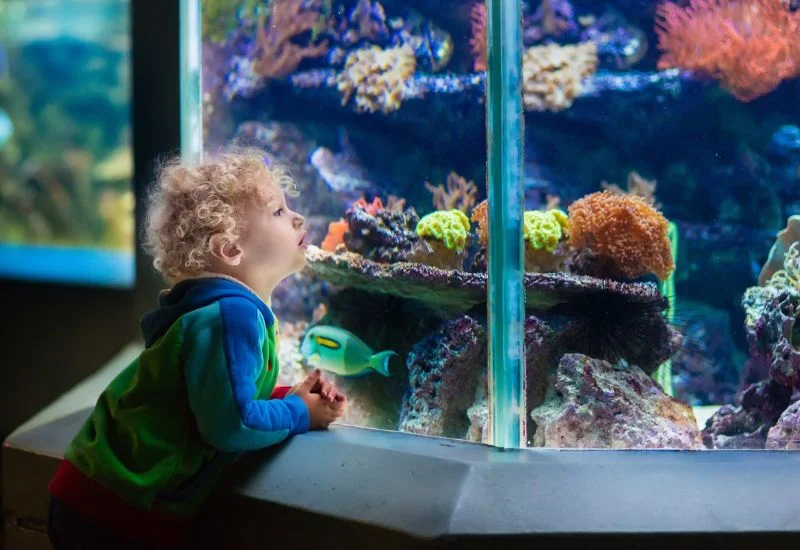Having an aquarium at home can be a thrilling experience. There are so many options and varieties to choose from. Setting up an aquarium can be a hard and challenging experience for beginners.
Choosing the right size of tank, substrate, plants, everything is interlinked with the species of fish you have. Selecting the wrong tank and material can severely cost the health of your fish. Here is the ultimate guide on aquariums to know what is best for your fish.
What is an Aquarium?

An aquarium is a vivarium of any size. At least one side of it is transparent, in which aquatic plants and animals are kept and displayed. The aquarium was fully developed in 1850 by chemist Robert Warington, who stated that placing plants in the water would provide oxygen to aquatic animals as they grow. The aquarists who own fish use aquariums in which they can live. The aquarium can be made of glass or acrylic, depending on the needs of the fish.
Best Place to Set up Your Aquarium
The best place to set up an aquarium is where there is no exposure to direct sunlight. Direct sunlight is harmful to fish, and it can cause algae growth in the tank. A place with less traffic would be a great option—for example, a quiet corner or the middle of the house. Ensure the place or floor is strong enough to hold the aquarium’s weight. Try to set the aquarium where there is less noise. For example, the noise of television can put the fish under stress.
Setting Up Your Aquarium
Before setting up the aquarium, you need to know what things you should keep in mind:
Choosing the Right Aquarium
The size of the tank matters a lot when it comes to fishkeeping. The small tank is a good choice for beginners, but it’s hard to take care of a small tank as it needs more water changes than the big tank.
The water conditions do not change massively in the big tank as compared to small. The size of the tank is also interlinke with the species of fish you have.
Some fish species need a lot of space to swim, while some are not active swimmers and can live in a small tank. Make sure you know the needs of your fish and then choose accordingly.
Glass Tank
Here are the pros and cons of the glass tank:
- The glass tank is made from a natural material called silica
- Glass tanks are famous for their clarity and resistance
- The weight of the glass tank is quite concerning, especially for a big tank. It’s hard to manage when you need extra support for big tanks
- The tank provides a scratch-resistant view of aquatic life, ensuring clarity over time
- The glass tank is less prone towards yellowness on the tank
- In glass aquariums, the customization options are few and expensive
Acrylic Tank
Here are some points you should know about acrylic tanks:
- Acrylic tank is made of a plastic called polymethyl methacrylate
- The chemical bonding of the material results in making it lightweight
- The acrylic tanks became famous because of their optical clarity and lightweight
- The lightweight nature of the tank makes it easy to maintain, as compared to the glass tank
- This tank reduces the risk of placement options
- The acrylic tank may provide a good view, but its resistance capacity toward scratching is not good
- The acrylic tanks are more resistant to shuttering and cracking
- The acrylic tank is more open to the UV lights, which can change the aesthetic of your aquarium
- Acrylic tanks are highly customized and can be molded into any shape
- Best for aquarists who like to do creativity
Essential Equipment
Here are the equipments you need to set up your aquarium:
Filter
It is imperative to install a filtration system. The filter will eliminate all toxic chemicals and waste from the water and maintain the water quality.
There are three types of filtration from which you can choose:
Mechanical Filtration
Mechanical filtration demonstrates the physical removal of any waste from the water. For example uneaten food, or any waste material of plants. In mechanical filtration, we can use sponge filters, gravel filters, and pad filters.
Biological Filtration
Biological filtration is a method by which we establish colonies of beneficial bacteria in the water. The bacteria convert Ammonia to Nitrite and then to Nitrate, which is a less harmful form of chemical. The Nitrate further can be siphoned out. This cycle is called the nitrogen cycle.
In the biological cycle, we can use bio wheels, ceramic rings, and live rock. All three methods help in the growth of beneficial bacteria in your tank.
Chemical Filtration
Chemical filtration uses chemical characteristics of water to eradicate dissolvable material from the tank. This filter employs a specific media that captures the contaminants from the water by neutralizing them.
The typical examples of chemical filtration are zeolite, activated carbon, and phosphate removers.
Lighting
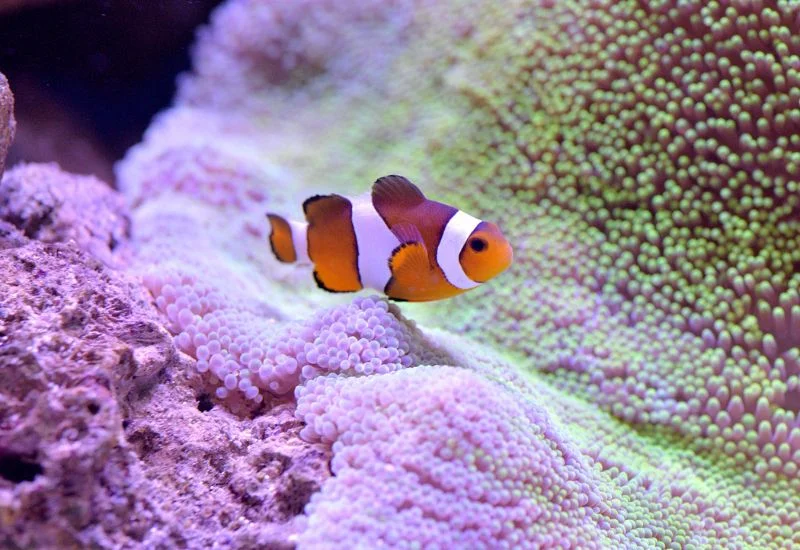
The lights play a huge role in the making of the aquarium’s environment. The aquarium needs light for the growth of plants, to form a cycle of day and night, and to provide growth in the mental and physical health of the fish. There are different lights that you can use, and you can adjust their intensity. More exposure to light can cause the growth of algae. You can choose the light by assessing some points:
Fluorescent Lights
You can use fluorescent lights. The light is distributed equally in the tank. The life span of these lights is less than that of LED lights.
LED Lights
LED lights are durable and consume less energy. The life span of the light is very long. The initial cost of the light is expensive, but in the long run, their whole cycle cost is lower. LED lights come in different colors and do not have the risk of overheating.
Compact Fluorescent Lights
The lights are suitable for the aquarium and can accommodate small light sources. The life span of the lights is less than LED lights. The lights work longer in high working hours.
Heaters
Water temperature has a massive impact on the health of fish. The fish from different regions require different water temperatures. Some fish live in cold waters, while some live in warm waters. Install a heater in your tank and adjust it according to the fish species you have. Install a thermometer with the heater so it can stop any fluctuation in the temperature.
Aquascaping
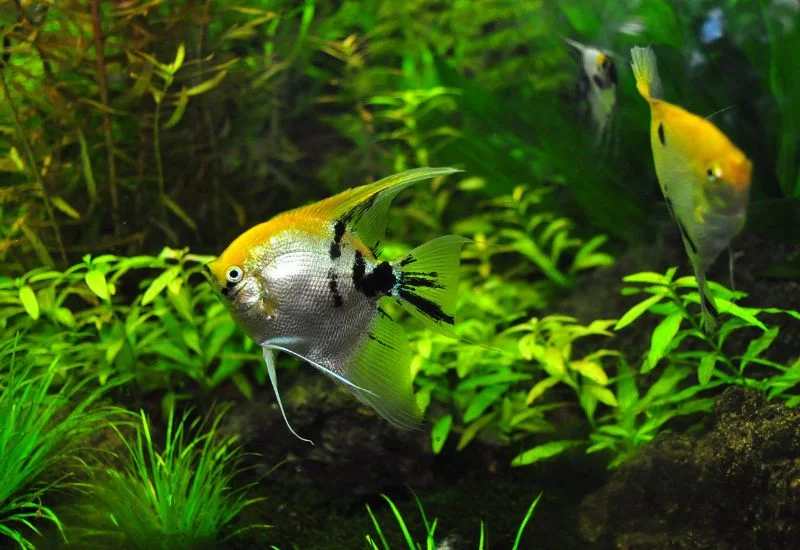
Aquascaping is the art of capturing nature in a small tank. You can choose the design from different layovers.
Dutch Style
In Dutch-style aquascaping, only live plants are used, with no need of rocks or driftwood.The plants do not represent any specific style of nature. The plants are put together to provide a even look.
Iwagumi – Japanese Aquascaping Style
In the aquarium, the slow-growing plants will provide a simple look. In this style, three rocks are placed in the aquarium. The big one is called the head rock, and two on the sides. This style also represents Japanese culture and harmony.
Nature Style
This is the most common type of style. The primary purpose of the style is to perfectly mimic nature. In this style, live plants, rocks, and driftwood are used. The inspiration for style comes from nature itself—For example, rivers, gardens, lakes, jungles, and mountains.
Step-by-Step Guide to Setting up Your Aquarium
Here is the detailed guide; let’s dive in:
Unbox the tank
Unbox your aquarium safely. Set up the stand if needed. Wipe out the inner side of the tank for any dust. The whipping cloth should be clean. There should not be any soap or detergent chemicals in the wipe. This is the best time to place the back wallpaper of your aquarium if you have any. The aquarium comes with lights, make sure to plug them on to check if the lights are working.
Set the Position of the Aquarium
When your tank is open, have wallpapers in place and put your tank in the position where you want to place it. Moving it now would be a lot easier than moving the tank when it was full of water.
Wash all Gravel
Before adding the gravel into the tank, rinse it with water. Water should not contain particulars of soap or detergent. The hot water will clean the gravel and ornaments from dust or any paint. After rinse, place them into the tank carefully.
Fill Your Tank
With the help of a hose fill your tank. Try to fill the tank slowly to avoid any cloudiness in the water because of the gravel. Add the salt water or fresh water according to the type of fish you are going to add.
Turn the Filter on
Turn on the electrical devices attached to the aquarium. For example filters, heaters and lights. For the start you can leave the lights off. You only need to provide 8 hours of the light. More duration of light can cause the growth of algae in the tank.
Add the Treatments
Before adding any treatments into the water like conditioner, biofilter product, read the instructions to add the right amount into the tank. These products will help in the establishment of beneficial bacteria in the tank.
Cycle the Tank
Allow your tank to cycle for a healthy environment. Before adding the fish, break the new tank syndrome. You can start by adding fish food into the water, which will convert into Ammonia, then Nitrite to Nitrate. After the cycling of the tank you can add the fish.
Maintain the Water Quality by Testing
Once you have added the fish the amount of harmful bacteria can be increased. To maintain the water quality you can check the water by using various kits available in the market.
Water Maintenance
To maintain the water quality do water changes on needed times. You can change the water in the tank according to your fish’s preference. Clean the filter of the tank. The filter removes all toxins from the water that can be clogged, checking the filters timely to maintain the water quality.
Water Quality Management
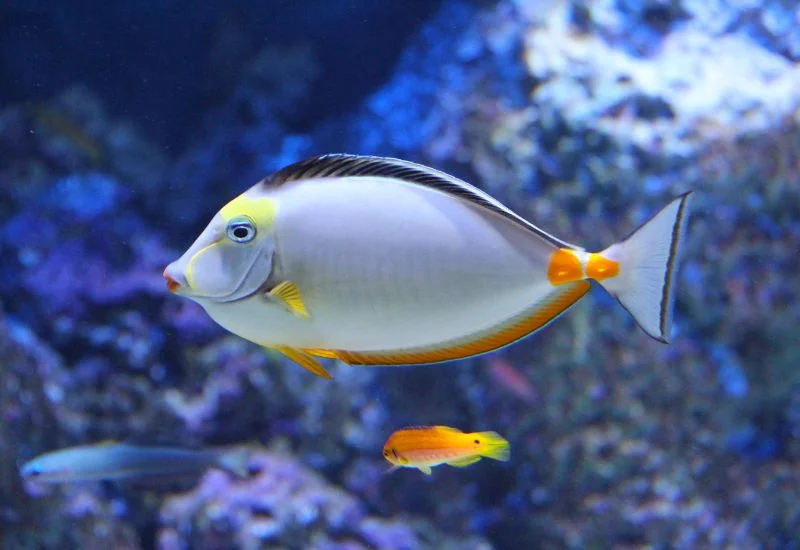
To ensure the water quality, look for any harmful chemicals. Due to the fish waste, more duration light, and uneaten food, the water parameters can be affected. Because of these factors, the amount of Ammonium Nitrite and Nitrate in water increases, which puts your fish under stress and causes health problems. Maintain the water quality by checking the pH level of water. pH level depends on the needs of the fish. Before adjusting the pH of the water, know your fish preferences. You can check the pH through several kits available in the market.
Importance of Water Movement
The water movement plays a massive role in the health of the fish. There are different water movements. For example waves, turbulence, surge laminar flow and steady stream. Choose the water movement style as per the preference of your fish.
The water movement maintains many factors, such as:
Provide Stable Water Conditions
The movement of water maintains the water conditions and health of the environment. It distributes the nutrients and water temperature ideally across the tank. Prevent stagnating water. The area of the tank where water stagnates promotes the growth of algae.
Balance Oxygenation in the Tank
The movement of water helps in the exchange of glasses on the surface of the tank that create an apple of oxygen for the fish. Fish, organisms and beneficial bacteria residing in the tank needs oxygen for survival. It also eliminates the harmful amount of carbon dioxide and maintains the water quality.
Fish Activity and Health
Water movement not only mimics nature but also strengthens the muscles of the fish. It impacts positively on the physical and mental health of the fish. Every fish has their preference for water movement. For example, betta is a slow-water fish, and high-current water can damage their fins. Before setting the flow, make sure of the preference of the fish you have.
Waste Management
Water movement is important for the waste management in the aquarium. The flow of the water pushes uneaten food towards the filtration. It also helps in the prevention of toxic buildup.
Troubleshooting Common Problems
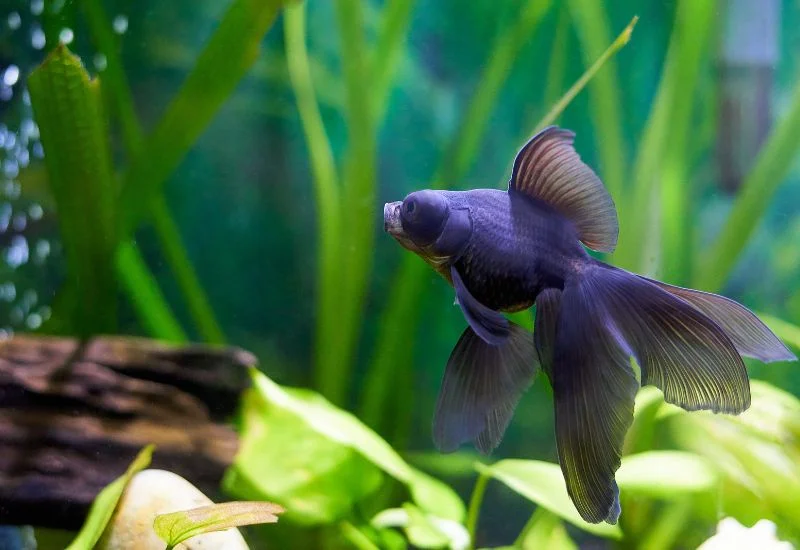
There are many common problems that can occur in the aquarium:
Growth of algae
The algae growth in the tank is the most common problem. The growth of algae can increase due to different reasons. Exposure to direct sunlight promotes the growth of algae. Do not place your tank in direct exposure to the sun.
More availability of LED light can cause the growth of algae. Fish only need 8 to 10hours of daylight. Set the timer to manage the duration—the amount of nutrients in the water, like phosphate, can be the cause of algae growth. Change the water in the aquarium at the times when needed to prevent the extra buildup of nutrients in the tank.
If the filter of the tank is not working right, algae can grow, too. You can add algae eating fish to control this unwanted plant.
Uneaten food
The uneaten food in the tank can make water cloudy. Do not overfeed your fish. Give them food that they can eat within 2 minutes. Remove the uneaten food after 5 minutes.
Expected Results in the First 60 Days
After setting up your aquarium, you will go through a lot of new experiences:
The First Five Days
- After setting up your tank, do not touch the fish for 48 hours
- The tank needs time for temperature adjustment and decoration
- After 48 hours, you can introduce your fish to the tank
- When you add new fish to the tank, the water can get cloudy because of bacterial bloom
- The bacterial bloom is usually harmless to the fish, but it’s a good time to check Ammonia, Nitrate, and Nitrite, and they must remain at zero
- Do not add too many fish at once. That may cause a massive fluctuation in Ammonia, Nitrate, and Nitrite
Five to Fifteen Days of Setup
- New surroundings of the environment may make your fish shy
- Your fish will hide at first
- Try to place many plants and decorations to provide plenty of hiding spaces.
- Do not turn the light on for some days
- Once your fish start to come out, you adjust the light timings accordingly
- Check the water for chemicals. You can set a filter in media that will prevent the rise of harmful bacteria
- Provide fish food only the amount that fish can eat in two minutes
- Once your first water cycle is completed, you can add new fish
Fifteen to Thirty Days of Setup
- When Ammonia starts to convert Nitrite to Nitrate, it’s high time that algae can bloom.
- The growth of the algae in the tank is normal
- You can use a scrubber or pad to remove algae
- Do not use the scurred, which is used with soap or detergent
- You can add algae-eating fish to your tank to control the growth of algae
- Check the water for Ammonia, Nitrate, and Nitrite. As long as the amount of these is zero, you can add the new fish
- When you add new fish to your tank, the existing fish become aggressive because they take them as intruders
- Try to change the decoration before adding a new fish and add a new plant for the new fish so the fish can feel at home
- Do the water change of the tank after 15 days
- Do not vacuum the gravel, as it may remove the good bacteria that have just started to settle
Thirty to Sixty Days After Setup
- Feed your fish twice a day as long as the Ammonia, Nitrate ans, and Nitrite remain zero
- Only provide food that your fish can eat in two minutes
- This will make your water clear and help in the sound digestive system of your fish
- Monitor the fish’s behavior to get to know your fish
- If there are white spots, rubbing against the objects, bad swimming pattern, more sleeping of your fish, swelling, or any of these which were not present before
- Take your fish to the veterinarian for a check. Your fish can be sick
Fish and Plant Selection

Before choosing the fish and plants for your tank, here are some points you should keep in mind:
Choosing the Right Fish
Choose the fish according to the characteristics and availability of resources you have. Some fish need more space, and some can live in small tanks. Some fish can live in communities like Neon Tetra. Neon tetra likes to stay in a group of 6 or more. Less than six will make them stressed. The fish is calm and friendly. On the other hand, betta fish are aggressive due to territorial issues. You can not add two male bettas in one tank. They will fight until one is dead.
Before choosing the fish, determine what fish species can stay together.
Choosing Plants
Live plants play a central part in providing a natural habitat for your fish. The plants not only provide a natural look and add to your tank’s aesthetic but also help in cleaning. The live plants consume the harmful chemical from the water and maintain the water quality. Before planting the plants check what plants are best for your fish.
If you are going for artificial plants, go for silk material-based plants. The leaves of those plants are gentle for the delicate fish. Before planting make sure leaves do not have sharp or hard ends.
As a beginner, you can try these plants: Bacopa caroliniana, Vallisneria, Aponogeton crispus, Amazon Sword and Cryptocoryne wendtii.
Feeding and Care
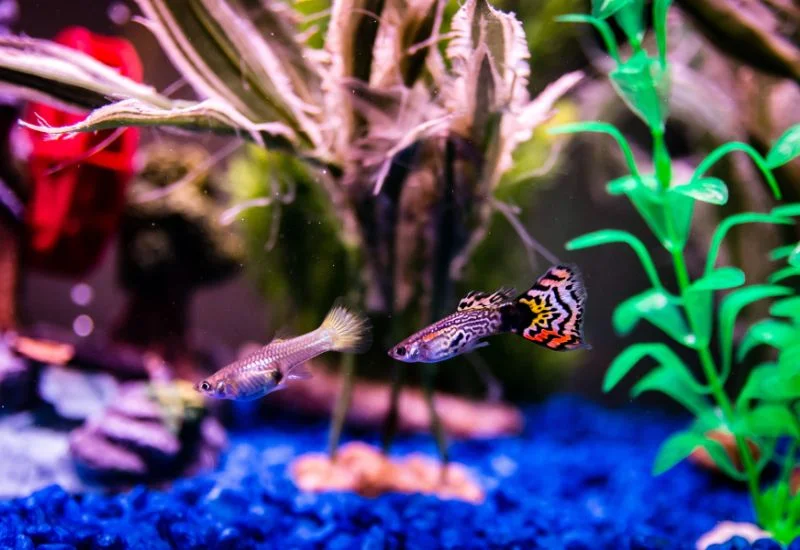
Here are some things you can do to keep your fish healthy:
Basic Fish Nutrition
Some fish are picky eaters, while some can eat anything. Some types of fish even eat uneaten food and algae from the bottom of the tank. Know the preferences of your fish and feed them accordingly. You can try frozen, brine shrimp, pellets, and live food.
Feeding Schedule
Fish do not eat in significant portions like humans. Fish eat in small portions one to two times a day. People usually overfeed the fish by thinking they eat like humans. They use food as communication channels and over-feed them. Fish recognize their owner whenever they come to the surface in excitement. People overfeed the fish for her excitement. Overfeeding fish can cause different health problems. Here are some signs that can show you are overfeeding your fish:
- First, only provide food to your that they can eat within 2 minutes. The food that remains after minutes, your fish is never going to eat that
- This is not only a sign of overfeeding, but uneaten food can temper the water quality
- The male guppies develop bulging chests or potbellies when they are overfed
- Fish will not respond to the food
- The waste tangled around the fish can be a sign of a blocked intestine
- Swelling in the abdominal of fish
- Difficulty in swimming
- Off swimming pattern and more lethargic and tired behavior
Adding New Fish into the Existing Tank
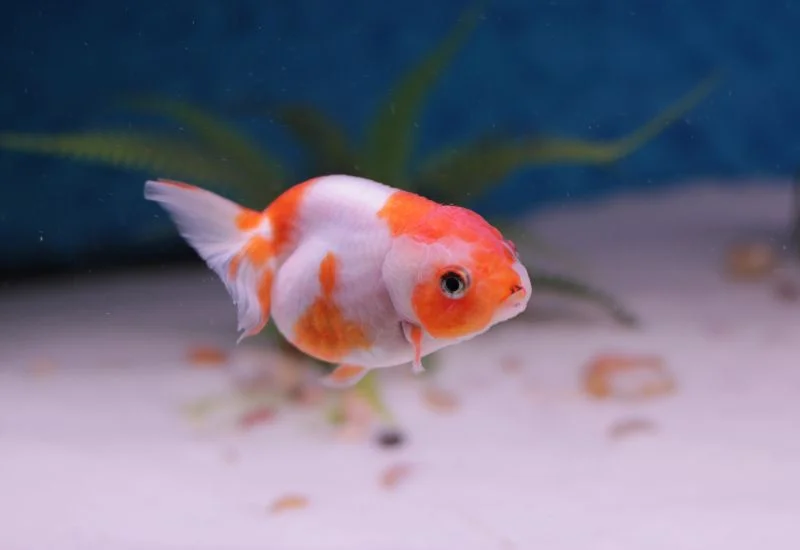
Before adding fish to the tank, there are some points you need to consider:
- Check the fish compatibility before adding the new one. Check if the fish can perfectly cohabit with the existing fish
- Check the water conditions and pH level as per the fish’s preference
- Before adding the fish, quarantine the new fish to check for signs of disease. The latest fish can get sick without showing any signs. Quarantine is the best option to assess and treat it right away
- Acclimate the fish before adding it to the tank
- You can use the drip method or the floating bag method for fish acclimation.
- After acclimation, you can add the fish to the tank
- Monitor the behavior of fish for any signs of stress or bullying
Common Fish Diseases and Prevention
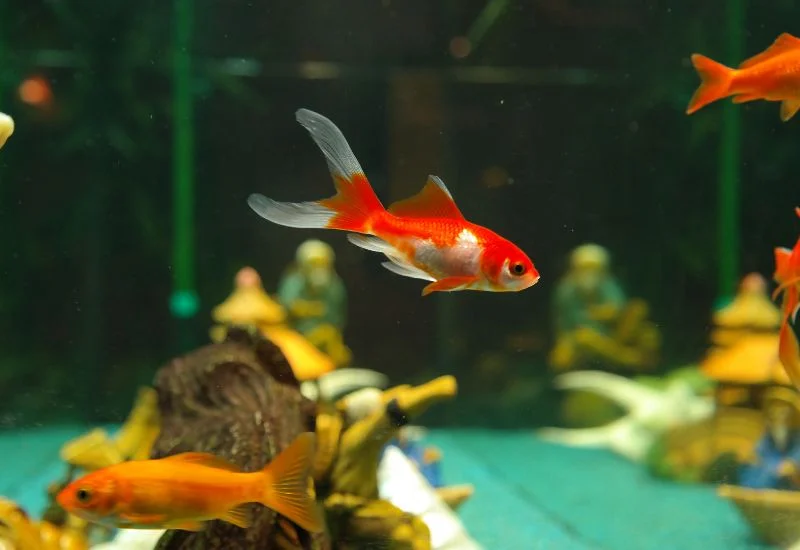
Here is the list of common fish diseases:
Ichthyophthirius Multifiliis Disease (ICK)
This is the most common health problem caused by parasites in the aquarium. The cause of the disease can be poor water quality, Crowded aquarium, sudden change in the water temperature or pH level or adding the infected fish into the established aquarium.
The fish with this disease can be assessed by symptoms like white dots on the skin. These dots can be seen with eyes over time. To treat the problem, a new tank in an ICK-free environment will be used. Check for the water quality. If the process is needed again, change the 20% percent of the water.
The other method to treat the problem is the use of salt. Sme fish species are resistant to salt. Before using it make sure to know what species you have.
Popeye Disease
If your fish is not feeling energetic, no appetite is left, and if you observe a change in its coloring, she might be suffering from popeye fish. Popeye is a wild disease in fish, and it is quite painful for this species. In this disease, a fish’s eye is swollen from the eye socket, which blurs the fish’s vision.Popeye disease
Bacterial Infection
The bacterial infection is also known as fin rot—the most common aquarium disease. The bacteria follow the injury done by parasites. The reasons for this can be poor water quality, poor diet, poor handling of fish, and changes in water temperature.
The symptoms of this disease can be rapid breathing, white spots on the skin and fin, cloudy eyes and bloody patches on the skin. To treat it use antibacterial medicines as per the prescription of the doctor. The medicine is not very effective in the water. Try to inject it with the food.
Fungs
Thesis disease is also known as mycoses. This causes a furry growth on the internal side of the fish. The reason for the disease can be poor water quality, dead fish, and infected food. The symptoms can be white to brown patches on the skin of the fish, pale gills and change in the appetite.
To treat the problem use antibacterial medicine. Put your fish into the quarantine tank and add salt to the water. To solve the problem other issues like water quality, crowded tanks, and uneaten food can be addressed.
Dropsy
Dropsy is also known as “pinecone disease”. The bacterial infection caused damage to the kidney of the fish. It causes swelling on the abdominal of the fish and can give it a shape of pinecone. The reason for this disease can be the aggressive tank mates, change in the water condition and poor handling of fish while transportation.
The symptoms of the disease can be swelling on the abdomen, pinecone appearance, and extended scales. To treat the problem, put your fish into a separate tank and maintain a temperature between 70° F and 75° F. Give a salt bath to your fish. The disease can be addressed by the use of medicine.
Brooklynellosis
The disease is also known as Brooklynella hostilis. This disease mainly affects the anemonefish but can cause the problem to other fish. The reason can be the entry of an infected fish, poor handling and stress in fish. The symptoms can be removal of tissues from the skin, color change of skin, abnormal breathing, loss of appetite and respiratory distress.
To treat the problem, 37% formalin, a solution of formaldehyde gas, water, and menthol, is used. For the best result, use formalin as a bath. Use 0.5 of formalin per gallon of water.
Rust or Gold Dust Disease
The rust or gold disease is also known as velvet disease. The disease is caused by a bacteria known as Odinium. The bacteria attack on the gills of the fish and can cause secondary bacterial infection. The reason can be poor water quality, dirt tanks, fluctuation in the water temperature.
The symptoms can be a yellowish appearance on the skin of the fish. The fish skin can be peeled off. The fish can be gasping for—trouble breathing and rubbing against the objects or against the walls of the aquarium.
Prevention of Overfeeding
- Before giving food to your fish, know about the species
- Every species has a different need for food
- If food stays in the tank after five miniatures of feeding, take a siphon and change the 25% of the aquarium’s water
- This will remove debris from the water and harmful chemicals
- Before feeding your fish, measure the portion size as per the recommendation
- You can use an automatic feeder that can measure the food quantity and release food in the tank as well
- You can also use a feeding ring that will keep the food in the box, not spread it in the tank, and keep the water clean
Care of the Aquarium
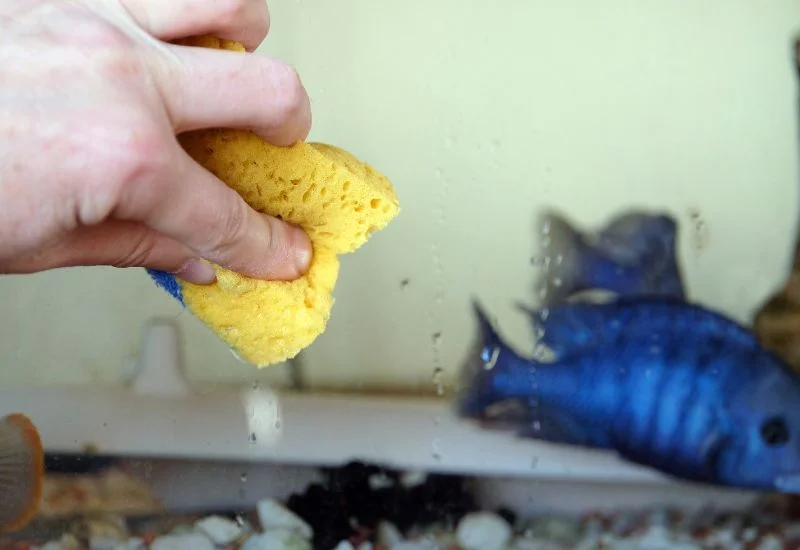
There are several things that you keep consideration for caring the aquarium:
- The visual inspection of the aquarium for any damaged compartments, low levels of water, or any other issues
- Check the water quality of the tank. There should be no amount of Ammonia and Nitrite
- Look for the algae. If there is algae growth on the walls of the tank, use a scraper to clean it
- Use a nifty aquarium siphon and vacuum one-third of the substrate
- Move the decorations as needed
- The vacuum not only clean the landscape, uneaten food, and dead leaves but it will also clears the old water in the aquarium with high-intensity Ammonia
- To keep the aquarium clean, you need to make sure the filter is not collected up
- Filter collects all the fish waste from the water and more work like a garbage bin
- You can clean the aquarium glass for a more clear look. You can use a glass cleaner or acrylic cleaner to clean the walls
Euthanization of Fish
There can be a lot of reasons for the euthanization of your fish. When there is no treatment, euthanization is the last option to put your fish on peaceful rest. Here are some reasons:
Dropsy
Dropsy is a painful disease that can occur to every fish and it’s hard to find the cause of it. In this disease a pinecone shape developed in the head of the fish. Over time it developed on both sides. It is brutal and painful for the fish. There are stages that can be cured. When the disease is incurable its time to say goodbye to your pet peacefully.
Old Age
Old age of the fish can cause several health problems. Low swimming, loss of appetite, more naps. The best way is to put your fish to euthanization to save her from these difficulties.
Physical Deformities
The fish is poorly developed because of birth or injuries. It’s hard for them to survive and live an everyday life. For them, euthanization is the best option to give them a peaceful goodbye.
Advanced Topics

Breeding Conditions and Techniques
Here are some factors you should consider for successful breeding and techniques:
Breeding Difficulty
Some species of fish are easy to breed like guppies while on the other hand some species need extra care in the proper breeding environment to breed like neon tetras. Before breeding, select a healthy pair of fish and know about their breeding requirements.
Compatibility of the Species
Before breeding, make your breeding pair and cohabit with other species in the tank. If they can live with others, that will cause stress and failure in breeding.
Aquarium Conditions
Before breeding, know the breeding requirements specifically. In breeding, the water temperature and pH level matter a lot. Make sure you have all the required resources for successful breeding.
Create Breeding Environment
Here are some points you should take into consideration:
Provide Breeding Shelter
Make sure to provide breeding spaces for your fish. Place plants and caves for hiding. Leave the place for spawning mops and a surface for eggs. The environmental conditions will influence fish towards breeding.
Mimic Natural Conditions
Some fish need to be kept in specific natural conditions for breeding. Foe explains the specific lightning, rainfall, pH level of water, and water temperature. Know about the fish spices you have and do accordingly.
High-Tech Equipment Upgrades
As the world is evolving, you can use high-tech equipment for better results:
Upgrading to a more advanced filter will not only enhance the water quality of the tank but also positively impact the health of your fish:
High-Efficiency Canister Filters
Manufacturers have introduced new technology in canister filters over the years. Selecting a high-efficiency canister filter will not clear the water but will handle the bioload with great capabilities. The filter will improve the flow rates of water, providing advanced filter media customization.
UV Sterilizers
The UV sterilizer in your tank will not only eradicate harmful microorganisms from the tank but also reduce the risk of infection. The UV sterilizer promotes a healthy environment for fish and coral.
Protein Skimmers
Protein skimmers are best for saltwater aquariums. They are efficient and reliable to enhance the water quality of your tank. They help in removing excess organic matter from the water. Prevent the build-up of nitrate and promote an ideal and healthy aquatic environment.
Ecosystem Enrichment
Upgrade the ecosystem of your tank not only elevates your tank esthetic but provides better conditions for your fish to thrive:
CO2 Injections
CO2 injections work for a planted aquarium; the injection system stimulates the growth of plants in the tank. Provide them a more vibrant and rich look and make the environment more natural.
Advanced Substrate
Upgrading the substrate of your tank will not only make it beautiful but also add the needed nutrients for a healthy environment.
Participating in the Aquarium Community
For more information, you can join the online forms and local clubs for information and experiences. You can post any question people will answer according to their expertise, or you can share your personal experience. There are several aquarium shows that you can join as well.
Conclusion
Setting up a new aquarium can be quite challenging. The selection of the tank and all addables in it play a massive role in forming the aquarium’s environment and maintaining the health of your fish. The selection of tank, substrate, gravel, plants, and water parameters should align with the requirements of your fish.
Before setting up the tank, know about the species of fish you have and act accordingly. Do not add too many fish at once, as it can increase the amount of Ammonia, Nitrate, and Nitrite in the water. Install a good filter that can manage biowaste and maintain water quality.
Do not overfeed them. Look for any odd behaviors that can be an indicator that your fish is sick. Providing the breeding grounds for your fish to provide them with better mental health. You join different communities and clubs where you can share your experience and gain knowledge.
